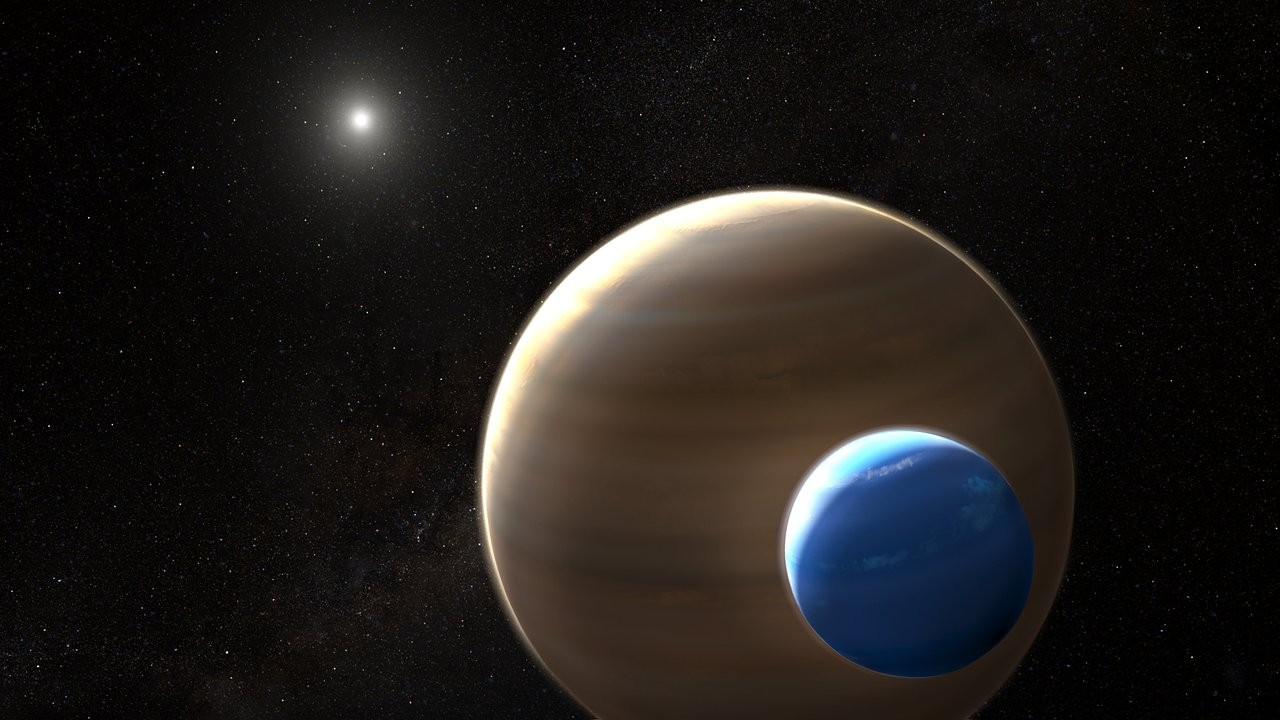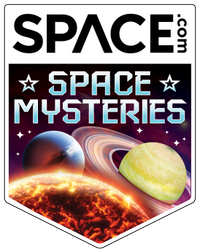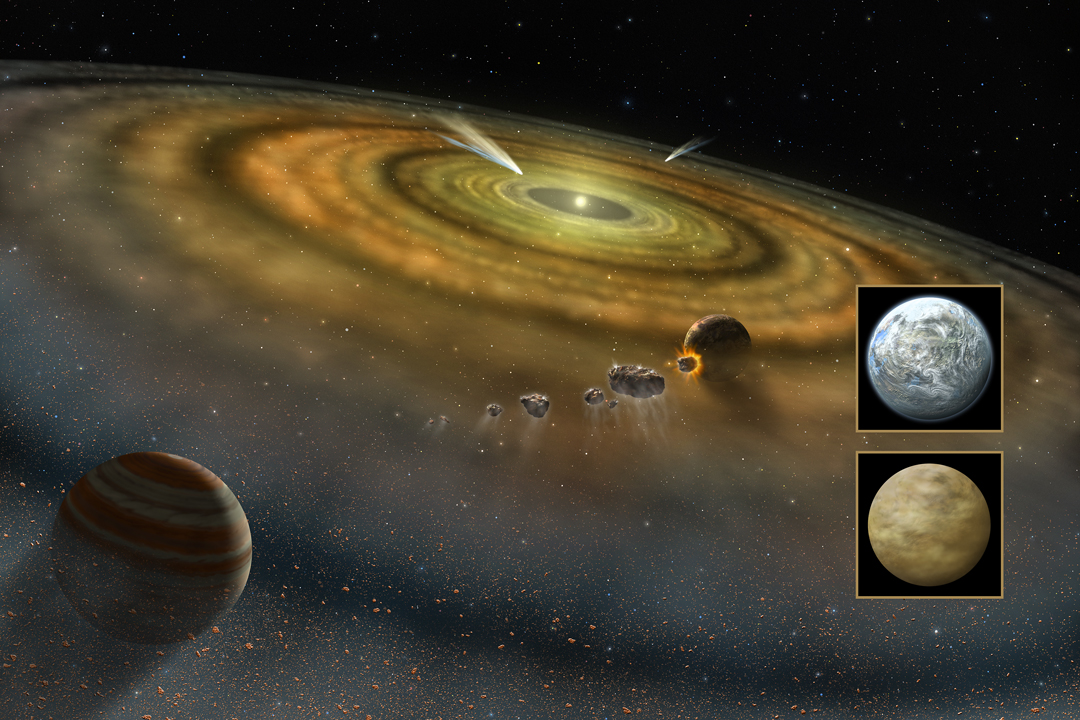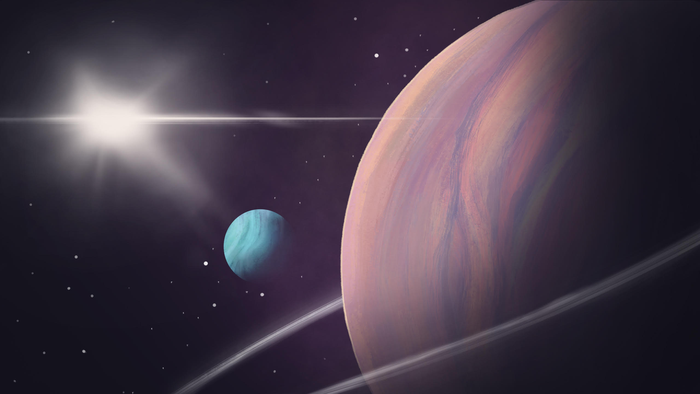Why are there no gas moons?
We have rocky moons, ocean moons and ice moons, but where are all the gas moons?


Moons come in many forms.
In our solar system we have rocky moons (e.g. Earth's moon), ocean moons (e.g. Europa and Enceladus) and frozen-ice moons (e.g. Triton) but there are no gas moons. Are we just unlucky not to have any gas moons, or are there physical reasons why they cannot exist?
Actually, there are gas moons! Though they are not in our solar system. Although more than 5,500 exoplanets have been discovered so far, only two possible exomoons have been spotted, and neither are 100% confirmed yet. What's weird about these two 'exomoons' is that they are gas giants, orbiting even larger gas giants! However, as we shall see, they are the exception that proves the rule.
Related: The 10 weirdest moons in the solar system
To understand why there are no gas moons, in our solar system at least, it's best to first understand how gas giant planets form.
There are two scenarios for gas-giant planet formation. One is referred to as 'bottom-up' formation, the other is 'top-down'.
Forming gas worlds from the bottom-up
Bottom-up, or 'core accretion', formation is how the gas giant planets of our solar system formed. If we could travel back in time 4.5 billion years, we would witness or young sun surrounded by a disk of gas and dust. This is the protoplanetary disk from which all the planets formed. First, they accreted as rocky bodies, growing as they gathered up dust, pebbles and asteroids. Some only grew as large as Mars or Venus, but others kept growing, forming giant rocky bodies with up to 10 times the mass of Earth.
Breaking space news, the latest updates on rocket launches, skywatching events and more!
Once they got this massive, they had gravity strong enough to start sweeping up large swathes of gas from the protoplanetary disk. Exactly how much gas they robbed and how large they grew depended upon their gravity and how much gas was available.
But in the end, our solar system was left with four gas giant planets — Jupiter and Saturn, and the colder 'ice giants' Uranus and Neptune. NASA's Juno mission to Jupiter has helped find evidence to support the core accretion model by detecting the gravity of a large, rocky yet diffuse core about ten times the mass of Earth at the center of Jupiter.
Forming gas worlds from the top-down
In the top-down model, gas worlds form directly from a collapsing clump of gas in a nebula, just like stars do. However, there is a minimum amount of mass that this process can produce.
As a large clump of gas contracts under the force of its own gravity, it heats up because the gas is being packed into an ever smaller, and therefore denser, volume. But when gas is warm it wants to expand, so in order to keep contracting, the gas clump must radiate away its excess heat. Consequently, we often see collapsing gas clouds glowing in the light of thermal infrared energy.
However, there is a constraining factor called the 'opacity limit for fragmentation'.
"Radiating away enough heat so that the gas can cool down and still collapse depends on the opacity of the dust, and the temperature and the density, and that process becomes much less efficient with smaller objects to the point where at about 3 Jupiter masses it cannot radiate out enough heat to keep collapsing," said Sam Pearson of the European Space Agency in an interview.
The smaller the volume, the more concentrated and opaque the dust becomes, and the process of radiating away the excess heat of gravitational contraction becomes increasingly inefficient. So nothing smaller than 3 Jupiter masses can be formed in the top-down process.
Why the solar system has no gas moons
Like their parent planets, most of the moons in our solar system formed through the bottom-up core accretion process in disks of leftover material that ringed their parent planets. Because the planets had already swept up most of the available material, there just wasn't enough left to form a moon massive enough to have enough gravity to hold onto a lot of gas. In fact, only one moon in the solar system even has an atmosphere, and that's Saturn's largest moon Titan.
Similarly, a top-down process could not have happened because there was not enough gas left over, and had it happened, at a minimum of 3 Jupiter masses it would have been the largest world in the solar system by quite some margin.
Odd moons
So, we can't form gas moons via the two most conventional processes of producing gas worlds. However, there are several oddities in the solar system that did form in a different way.
In the case of Earth, the moon probably formed from material blasted off Earth following a giant collision with a Mars-sized protoplanet. This debris formed a ring that built Earth's moon through core accretion. Could an impact on a gas giant planet eject enough gas to form a gas moon?
Unfortunately not. "Rocky planets can have impacts like that, but remember when comet Shoemaker–Levy 9 hit Jupiter [in 1994]? It jut vanished," Caltech's Jessie Christiansen told Space.com in an interview. "Gas giants eat anything."
Anything that collides with a gas giant is just subsumed by the gas giant and becomes part of it, rather than ejecting debris into space.
Another oddity are captured moons. For example, Mars' two moons Phobos and Deimos are captured asteroids. Saturn's outermost moon Phoebe is a captured cometary object, and Neptune's moon Triton is a captured Kuiper Belt object. They didn't form around a planet, but instead formed on their own in space, and later wandered too close and got caught by a planet's gravity.
This begs a question, could a smaller gaseous planet get captured by a bigger gas planet? After all, gaseous worlds can get as massive as a dozen times the mass of Jupiter, so in principle they could easily snag a gas world with, say, the mass of Neptune.
The gas exomoons
It seems that indeed they can! "It may be the case that there are Neptune-sized moons around giant exoplanets," said Christiansen.
The two candidate exomoons mentioned at the beginning of this article — Kepler 1625b-i and Kepler 1708b-i — are both gas giants in their own right, but they appear to be satellites to even larger gas giants.
"I will stress that both of these are candidates," said Christiansen. "We see something in the data that is consistent with a moon, but there are other things that could explain it too."
Assuming it is a real moon, then Kepler 1625b-i has a mass 19 times that of Earth (about 6% Jupiter's mass), making it similar in mass to Neptune, and it accompanies a gaseous planet with 30 times Earth's mass and a diameter half that of Jupiter.
Kepler 1708b-i is probably less massive than Kepler-1625b-i, with a diameter about five times the size of Earth (about half that of Kepler-1625b-i) and it orbits a giant planet 4.6 times more massive than Jupiter.
"They challenge a lot of theories," said Christiansen. "It's hard to come up with a way that they formed like that, so they must have been captured."
Being captured objects would make them similar, in principle, to the captured moons in our solar system. They would have formed like planets from core accretion in a disk and then become captured because of their migration in towards their star.
Migration appears to be a common process in young planetary systems. It is how astronomers explain "Hot Jupiters," which are gas giants very close to their star but which could mot have formed that closely. In the case of the exomoons Kepler 1625b-i and 1708b-i, as they migrated in they got caught by bigger planets that lay in front of them.
However, despite all this, they are probably not true moons! Instead, they are both probably examples of double planets rather than exomoons. A double planet is when both worlds orbit a common center of mass in the space between them, rather than one orbiting around the other. We have a double planet in our own Solar System, in the guise of Pluto and its largest companion, Charon.
So, there are gas moons, of a sort — but to make them, nature has to cheat!

Keith Cooper is a freelance science journalist and editor in the United Kingdom, and has a degree in physics and astrophysics from the University of Manchester. He's the author of "The Contact Paradox: Challenging Our Assumptions in the Search for Extraterrestrial Intelligence" (Bloomsbury Sigma, 2020) and has written articles on astronomy, space, physics and astrobiology for a multitude of magazines and websites.



